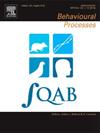Noise-induced vocal shifts in the Himalayan Monal (Lophophorus impejanus) vocal distribution in two different habitats
IF 1.3
4区 生物学
Q4 BEHAVIORAL SCIENCES
引用次数: 0
Abstract
Anthropogenic noise, an unexpected consequence of human activities, is disrupting the natural habitat of the Himalayan Monal and affecting its vocal communication. This study examines the impact of noise on the vocal frequency characteristics of this species across two distinct habitats, one exposed to anthropogenic noise and the other relatively undisturbed. Call parameters and noise variables were analyzed through quantile regression to understand how vocal behavior is influenced in different acoustic environments. The analysis considered multiple quantiles, including the 10th, 25th, 50th, 75th, and 95th percentiles, to capture the full range of variation in vocalization patterns. Our study is based on two hypotheses, the first hypothesis proposes that noise influences call frequency, resulting in an increase in call frequency as a response to noise. The second hypothesis suggests that call duration, particularly at the upper 90 % quantiles, exhibits varying responses to noise across different habitats, with longer calls occurring in noisier environments at higher quantiles. The results indicate that at the 10th, 50th, 75th, and 95th quantiles of call peak frequency, the pseudo-R squared values increased to 0.231, 0.215, 0.454, and 0.734, respectively, suggesting an improvement in model fit at higher quantiles. At the 95th quantile, the model accounted for approximately 73.4 % of the variation in peak frequency, whereas lower quantiles, such as the 10th and 50th percentiles, exhibited lower explanatory power. The Mean Absolute Error increased with rising quantiles, from 142.14 at q= 0.1–185.49 at q= 0.95, indicating greater variability in peak frequency at higher quantiles. This trend suggests that noise and vocal characteristics exert a more pronounced influence on the upper range of the vocal distribution, particularly at higher call frequencies, compared to lower frequencies. Additionally, a slight difference in call length was observed.
两种不同栖息地喜马拉雅驼峰(Lophophorus impejanus)声音分布的噪声诱导发声变化
人为噪音是人类活动的一个意想不到的后果,它正在破坏喜马拉雅山雀的自然栖息地,并影响其声音交流。本研究考察了噪音对该物种在两个不同栖息地的声音频率特征的影响,一个暴露于人为噪音,另一个相对未受干扰。通过分位数回归分析呼叫参数和噪声变量,了解不同声环境对发声行为的影响。该分析考虑了多个分位数,包括第10、25、50、75和95个百分位数,以捕捉发声模式的全部变化范围。我们的研究基于两个假设,第一个假设提出噪音影响呼叫频率,导致呼叫频率增加作为对噪音的响应。第二个假设表明,叫声持续时间,特别是在 %以上的分位数,在不同的栖息地表现出对噪音的不同反应,在更高分位数的嘈杂环境中出现更长的叫声。结果表明,在呼叫峰值频率的第10、第50、第75和第95分位数处,伪r平方值分别增加到0.231、0.215、0.454和0.734,表明在更高分位数处模型拟合得到改善。在第95个分位数处,该模型对峰值频率变化的解释约为73.4 %,而较低的分位数,如第10和第50个分位数,其解释能力较低。平均绝对误差随着分位数的增加而增加,从q= 0.1时的142.14增加到q= 0.95时的185.49,表明高分位数时峰值频率的变变性更大。这一趋势表明,与较低的频率相比,噪音和声音特征对声音分布的较高范围产生更明显的影响,特别是在较高的通话频率下。此外,观察到通话时长略有不同。
本文章由计算机程序翻译,如有差异,请以英文原文为准。
求助全文
约1分钟内获得全文
求助全文
来源期刊

Behavioural Processes
生物-动物学
CiteScore
2.70
自引率
7.70%
发文量
144
审稿时长
4-8 weeks
期刊介绍:
Behavioural Processes is dedicated to the publication of high-quality original research on animal behaviour from any theoretical perspective. It welcomes contributions that consider animal behaviour from behavioural analytic, cognitive, ethological, ecological and evolutionary points of view. This list is not intended to be exhaustive, and papers that integrate theory and methodology across disciplines are particularly welcome.
 求助内容:
求助内容: 应助结果提醒方式:
应助结果提醒方式:


